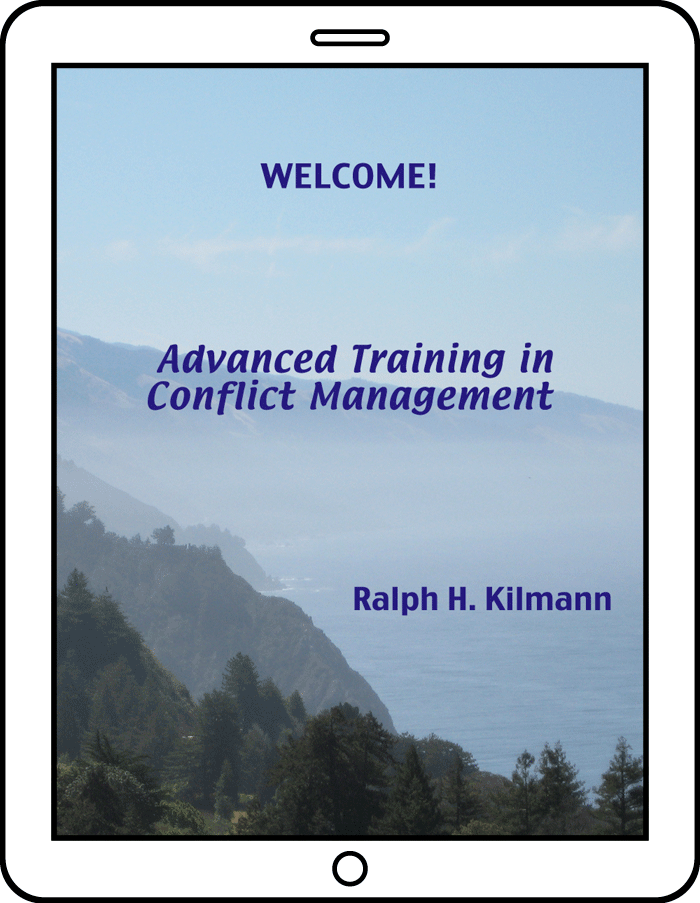
How to combine this online course with live discussions
The members of the same work group (whether a department, task force, project group, cross-functional team, or process improvement team) will gain extra benefits from taking any of our online courses AS A GROUP. Rather than members of an organization taking our online courses separately and thus independently, learning key principles and practices with your workplace colleagues will not only enhance what every member learns from our online courses, but will also make it much easier to apply what is learned back on the job—where it counts.
Basically, when all group members (1) learn the same language and the same concepts, (2) review the same assessment tools and their personalized results, (3) analyze and discuss the same business cases, and (4) follow the same guidelines for effective behavior—BECAUSE all these principles are fully shared in the group, they are more likely to be put into practice when challenging problems and conflicts appear in the workplace.
On this page, I outline how a work group can take full advantage of all the valuable materials in ADVANCED Training in Conflict Management. The unnumbered paragraphs describe what members are asked to do on their own, such as watch the course videos, take assessment tools, or complete work sheets in their course manual. Meanwhile, the numbered paragraphs provide the detailed steps for learning the material through face-to-face or virtual group meetings. Depending on the unique circumstances and needs of each group, this process for blended learning can be adjusted or expanded.
THE DETAILED STEPS
In those cases when the group skipped the BASIC course (because of prior training in conflict management), each member should first complete the Thomas-Kilmann Conflict Mode Instrument (TKI) with these modified instructions:
INSIDE your group, how do you usually respond when you find your wishes differing from those of another group member?
When members are about to take the TKI assessment, instruct them to IGNORE the standard TKI instructions that appear on their computer screen or Internet tablet. Instead, they should keep in mind the modified TKI instructions (and the members of their group) as they respond to all 30 A/B items on the assessment.
Before watching the videos in the ADVANCED course, members should also take the Myers-Briggs Type Indicator (MBTI), if they haven’t taken this assessment in the past few years or if they no longer have access to their personalized report. As a supplement to the MBTI, members might take Kilmanns Personality Style Instrument (KPSI), which measures psychological type specific to work situations (while the MBTI assesses a person’s type across all situations).
After all members have individually reviewed their TKI, MBTI and KPSI results, they separately watch the first few video sections, which covers pages 1 to 37 in the Course Manual for Advanced Training in Conflict Management. In a thirty to sixty-minute meeting (the amount of time will vary whether or not the group skipped the BASIC course), members address this item:
1. As a group, members discuss the five numbered paragraphs (1 to 5) on this page: Blended Learning for BASIC Training in Conflict Management. The group’s tally of its high 25% and low 25% conflict modes can be plotted on pages 22 and 23 in the Course Manual for Advanced Training in Conflict Management. NOTE: Even if the group first took BASIC Training, it might still be worthwhile to review what they have previously discussed before moving on to the more complex material in ADVANCED Training.
On their own, group members watch the next video section on Foundations of Psychological Type, which covers pages 38 to 63 in the manual. Afterward, the group meets for about thirty to forty-five minutes to discuss these numbered paragraphs:
2. As a group, members spend some time making sure that everyone understands the dimensions of psychological type (extraversion–introversion, sensation–intuition, thinking–feeling, and perceiving–judging) and especially the four middle two combinations: ST, NT, SF, and NF.
3. Based on each person’s MBTI (or KPSI) results, make a tally of the variety of psychological types in the work group. Indicate how many ST, NT, SF, and NF types are present, by writing the numbers onto the figure on page 41 in the manual. Knowing this distribution of types will be invaluable for the subsequent online courses as well as for all workplace discussions.
4. Make sure that all members examine how their psychological type might compel them to overuse or underuse one or more of the five conflict modes (see page 56 and 57 in the manual). With this knowledge, it will be much easier for group members to compensate for their natural tendency to rely on some modes more or less than others.
On their own, group members watch the video section on Group Process, which is on pages 64 to 80 in the manual. Following, the group spends about thirty minutes discussing these items:
5. As a group, members review the ten key principles of group process and the Process Observer (PO) Form (especially pages 77 to 80). Consider how to recognize the specific behaviors that either support or undermine those key principles in workplace meetings.
6. Discuss the process by which your group will appoint a Process Observer (PO) for every meeting and how the group will make the best use of the feedback that the PO provides at the end of the meeting (as outlined on page 76). The group should also consider the sequence by which members will take turns serving as the PO during workplace meetings. And the group should discuss what it means if they “forget” to assign a PO and thus fall back on their habitual (typically dysfunctional) group behavior.
On their own, group members watch the video section on Introduction to Problem Management, which is on pages 81 to 103 in the manual. Also on their own, they watch the video section on the Paul Marshall’s Case, which reviews the Work Sheets on pages 103 to 114. But members hit the PAUSE BUTTON soon after the video shows a beautiful clearing in the forest with a single wooden chair. If members haven’t done so already, they next read and study the case itself on pages 104 to 110. Afterward, they individually complete the work sheets on pages 112 to 114. Next, the members reconvene and discuss the following items in a sixty-minute meeting:
7. As a group, members review the instructions on page 103 (A Group Discussion on Problem Management), appoint the Process Observer (who makes use of the PO Form on pages 77 to 80), and then plan how the meeting will be conducted. Next, each group member shares the problems that were sensed and how to define them (page 112), what solutions are expected to close the identified gaps (page 113), and how to implement the chosen solutions and evaluate the results (page 114). After the individual sharing has concluded, the group members develop a consensus on their approach to problem management for this case study.
8. Toward the end of the group discussion, in five to ten minutes, the PO shares his or her assessment of how well the ten principles of group process were applied during the meeting. The group as a whole then discusses how it will improve its group process the next time it meets.
On their own, group members return to the video and hit the PLAY BUTTON, which was previously paused on the scene of a clearing in the forest with a single wooden chair. As the video begins, the scene switches to a serene path in the forest with a wooden fence on the right side of the path. At this time, I present my analysis of the Paul Marshall’s Case—which will have the most value AFTER the group has already completed and discussed the Work Sheets on Using Problem Management.
9. As a group, members list the similarities and differences between its analysis and my analysis of the case study. The group then summaries what it learned through this comparison (taking special note of any gaps) and then agrees on how to approach its workplace problems with these same principles and practices.
On their own, members watch the next two video sections, The Nature of Problems and The Problem Management Organization (PMO), which appear on pages 115 to 131 in the manual. Next, in a thirty-minute meeting, they discuss these items:
10. As a group, members review the process by which a PMO minimizes the most damaging errors in problem management for the most complex problems and conflicts facing an organization. Why is it so important to first magnify differences across the C-Groups before resolving those differences within an S-Group? Members then outline the key principles for designing and using a PMO, so this “collateral organization” has the best chance to succeed with all five steps of problem management.
11. How can these PMO principles and practices be applied in one work group of just three to ten members (or whatever happens to be the size of the current group)? Members then list some recurring workplace problems that would benefit from making use of these PMO principles and practices.
12. How will the work group implement some version of the first three tracks in order to make sure that it has a healthy behavioral (or quantum) infrastructure for problem management—and a PMO?
13. Did the group remember to assign a PO and plan the process BEFORE it proceeded with the content of this meeting? Did members remember to allocate a few minutes toward the end of the meeting to receive and discuss the PO’s feedback? If the answer is “no” to either question, members should discuss why they “forgot” to use this necessary method for improving group process.
On their own, group members can take the optional Final Exam for Advanced Training in Conflict Management, as described on page 132 of the manual and explained on the last video section of the course: Graduation. Upon successful completion of the Final Exam (receiving at least 88 out of 100 total points), each member receives the Certificate for Advanced Training in Conflict Management. Obtaining this certificate signifies that the person has learned the key principles of the course—and is now ready to apply them in the workplace.
NOTE: The optional Final Exam for every course can be taken as many as five times, since its purpose is to encourage members to learn the material—not to add stress to their life. However, if someone else purchased these courses for the group, the sponsor (for example, the employer) might require group members to pass each exam as an indication that they’ve learned the material. But Kilmann Diagnostics will not share any exam results if a member happens to score less than 88 points on any occasion for any course. We’ll only inform the sponsor when members pass their exams. Click to see Sample Questions on Each Final Exam.




